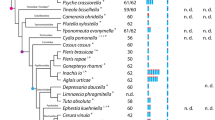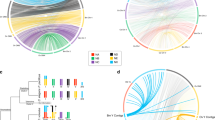Abstract
CONSIDERABLE progress has been made in developing the formal genetics and cytogenetics of several insect vectors of disease1,2, notably with mosquitoes, houseflies and tsetse flies in which the polytene chromosomes provide suitable material for detailed analysis of chromosome morphology. The triatomine bugs (Hemiptera, Reduviidae) are medically important as vectors of Chagas' disease in the Americas, yet cytogenetic information on these insects is meagre3–8. These bugs present the same problems which, until recently, limited developments in mammalian cytology in that they possess a large number (typically 2n = 22) of small, almost indistinguishable chromosomes7. Further, since their chromosomes are also holokinetic9 (that is with non-localised centromeres) they do not show any primary constrictions and it is correspondingly difficult to recognise arms of a chromosome which are readily seen in chromosomes of organisms possessing discrete centromeres. This difficulty with triatomine material has now been overcome by applying the Giemsa staining methods, which have been effectively developed by mammalian cytologists10–13, to embryonic cells of bugs with metaphase configurations. The technique I describe here makes possible the identification of individual chromosomes within the complements of different species of triatomine bug.
This is a preview of subscription content, access via your institution
Access options
Subscribe to this journal
Receive 51 print issues and online access
$199.00 per year
only $3.90 per issue
Buy this article
- Purchase on Springer Link
- Instant access to full article PDF
Prices may be subject to local taxes which are calculated during checkout
Similar content being viewed by others
References
Genetics of Insect Vectors of Disease (edit. by Wright, J. W., and Pal, R.), (Elsevier, Amsterdam, 1967).
The use of Genetics in Insect Control (edit. by Pal, R., and Whitten, M. J.), (Elsevier, North-Holland, 1974).
Payne, F., Biol. Bull. mar. biol. Lab. Wood's Hole, 16, 119–166 (1909).
Manna, G. K., Proc. zool. Soc., Bengal, 3, 155–161 (1950).
Schreiber, G., and Pellegrino, J., Scientia genet., 3, 215–226 (1950).
Barth, R., Mems Inst. Oswaldo Cruz., 54, 599–616 (1956).
Ueshima, N., Chromosoma, 18, 97–122 (1966).
Schreiber, G., Bogliolo, A. R., and De Pinho, A. C., Revta bras. Biol., 32, 255–263 (1972).
Hughes-Schrader, S., and Schrader, F., Chromosoma, 12, 327–350 (1961).
Sumner, A. T., Evans, H. J., and Buckland, R. A., Nature new Biol., 232, 31–32 (1971).
Drets, M. E., and Shaw, M. W., Proc. natn. Acad. Sci. U.S.A., 68, 2073–2077 (1971).
Schnedl, W., Chromosoma, 34, 448–454 (1971).
Patil, S. R., Merrick, S., and Lubs, H. A., Science, 173, 821–822 (1971).
Evans, E. P., Breckon, G., and Ford, C. E., Cytogenetics, 3, 289–294 (1964).
Author information
Authors and Affiliations
Rights and permissions
About this article
Cite this article
MAUDLIN, I. Giemsa banding of metaphase chromosomes in triatomine bugs. Nature 252, 392–393 (1974). https://doi.org/10.1038/252392a0
Received:
Issue Date:
DOI: https://doi.org/10.1038/252392a0
This article is cited by
-
Acetylation of ?-tubulin in male meiotic spindles ofPyrrhocoris apterus, an insect with holokinetic chromosomes
Protoplasma (1996)
-
Meiotic differences between three triatomine species (Hemiptera, Reduviidae)
Genetica (1985)
-
Autosomal synaptonemal complexes and sex chromosomes without axes in Triatoma infestans (Reduviidae; Hemiptera)
Chromosoma (1979)
Comments
By submitting a comment you agree to abide by our Terms and Community Guidelines. If you find something abusive or that does not comply with our terms or guidelines please flag it as inappropriate.



